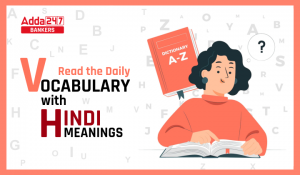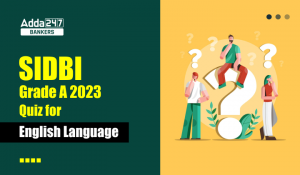Direction (1-10): Below in each question, some sentences are given, find the sentence which is not really contributing to the main theme and OUT of the passage or find the odd sentence and rearrange the remaining sentences to make a coherent paragraph.
Q1.
A. The government was a major contributor to investments in seed research in India for close to three decades after independence.
B. There was no IP law for the seed industry till The Protection of Plant Varieties and Farmers’ Rights Act (PPVFRA), 2001, came about
C. Policy reforms like the New Policy On Seed Development (1988) and New Industrial Policy (1991), and advances made by science and technology, provided an impetus to the participation of the private sector in the Indian seed industry and private investments helped India benefit from hybrid seed technology and biotechnology.
D. For many decades, the Indian policy framework facilitated the interaction of science and innovation with entrepreneurship, which led to competition and the subsequent development of an industry structure that delivered sustainable economic benefits.
(a) ACB
(b) DCB
(c) CBA
(d) DAC
(e) CDA
Q2.
A. The region has been the locale for some of the bloodiest inter- and intra-state wars in the 20th century and promises to be the theatre for similar conflagrations in the foreseeable future between failing, emerging and established nuclear-armed countries.
B. This potential for conflict is exacerbated by the absence of a robust regional peace and security architecture.
C. The term “Indo-Pacific” has long been in vogue among marine biologists and ichthyologists to define the stretch of water from the tropical Indian Ocean, through the equatorial seas around the Indonesian archipelago, the South China Sea, and to the western and central Pacific Ocean.
D. For instance, in 2015 the foreign secretaries of Australia, India and Japan met ostensibly to firm up the security leg of India’s “Act East” policy.
E. The term entered the geopolitical lexicon only in the early 21st century and, predictably, has proved to be far more contentious than its scientific definition.
(a) ACBD
(b) EDCB
(c) ACDE
(d) AEDB
(e) CEAB
Q3.
A. The government has already set things rolling by creating a panel to ready a blueprint for the rollout of 5G mobile networks in India by 2020, a move that not only promises to make wireless connections seamlessly fast but will also provide for the spread of internet-connected smart devices.
B. The telecom industry in India has evolved over the past few years, seeing numerous changes from 2G to 4G.
C. The network operates by connecting computers and peripherals using switches, routers, and access points.
D. Today, mobile handsets not only function as the means of communication with our loved ones but also as a source of entertainment.
E. Now, fifth-generation, or 5G, technology is on its way to not only changing the way we communicate but also paving the way for new consumer-technology interactions.
(a) ADEC
(b) BDEA
(c) DBEA
(d) BCDA
(e) DAEC
Q4.
A. Those who had friends and families living outside Darjeeling were unable to communicate with each other and assure them of their well-being.
B. Sometimes I wonder if going online is an action or a behaviour. Or if it’s an action that converts into a habitual behaviour, like brushing your teeth.
C. We brush our teeth every morning but we do it as a routine, often mechanically, barely noticing we’re brushing our teeth yet it is an integral part of our day.
D. Similarly, being online is a behaviour that once you get used to, it is difficult to stay disconnected.
E. Besides, when an action becomes a habit, it becomes difficult to live without it.
(a) CBAD
(b) BAED
(c) CEDA
(d) BCED
(e) CADE
Q5.
A. This has proven a boon for the aerospace industry. Globally, in the next two decades, more than 41,000 aircraft are expected to be produced, with a value of over $6.1 trillion.
B. Across the globe, rising wealth and the advent of discount airlines have made air travel more of a mass proposition than ever before.
C. This bounty will flow not only to plane manufacturers but also to a range of supporting parts and service suppliers.
D.A monthly cap of Rs10,000 for each means users may only use them for such use cases as utilities, telephone bills and so forth.
E. At the same time, the boom in electronic and mobile commerce has increased air-freight volumes as consumers order goods across borders, demanding speedy delivery.
(a) BCEA
(b) DBCA
(c) BEAC
(d) EADC
(e) EABC
Q6.
A. These are the electrodes that record the impulses of individual cells, ideally simultaneously with lots of others, in order to try to work out how networks of cells process information.
B. Until the invention of the microscope, microbiology did not exist. Neuroscience, too, has advanced recently on the back of some powerful tools, particularly techniques for scanning whole brains.
C. But the devices that look at the nitty-gritty of how nerve cells themselves work are still Heath-Robinson affairs.
D. For example, since the 2016 edition, the indicator on ease of getting electricity began to include indicators on the reliability of supply, price of electricity, and transparency of tariffs.
E. Science is a mixture of the intellectual and the practical. And the practical requires tools. Until the invention of the telescope, astronomy had been stuck in a rut for millennia.
(a) BCDA
(b) CAED
(c) DBCA
(d) BACD
(e) EBCA
Q7.
A. He speculated that both types of sounds were important for sending signals to others, but was unsure If this was true. In the years that have passed since his death, ornithologists have proved time and again that birds’ songs, squawks and shrieks are used for sending signals to their kin, their rivals and sometimes even their predators.
B. Such quick fixes may even be effective, but will only remain under the glare of the media.
C. In “The Descent of Man and Selection in Relation to Sex” he devoted equal space to both the sorts of sounds that emerge from birds’ beaks and the more percussive noises that they make with other parts of their bodies, such as their feet and feathers.
D. In contrast, their more percussive sounds have received almost no attention at all . A study published in Current Biology by Trevor Murray at the Australian National University, in Canberra, however, suggests that is a mistake. At least one bird creates a specific, audible warning with the flapping of its wings.
E. CHARLES DARWIN was fascinated by bird communication.
(a) DCAB
(b) CABD
(c) ECAD
(d) ECAB
(e) CAED
Q8.
A. They have also taken to flirting with deep science to achieve a part of this vision.
B. The common refrain is that IT services firms are not original enough and seek to profit only on the deep technology advancements made by other firms, usually based in Silicon Valley.
C. However, to be fair, Infosys Ltd and some of the other firms in this category such as Wipro Ltd and Tata Consultancy Services Ltd (TCS) have actually been hard at work to retool their operations to allow for the creation of new technology “products” such that these become an increasingly important part of their eventual go-to-market propositions.
D. Information technology (IT) services providers are often faulted for not having any “original” product ideas.
E. Meanwhile, private industry can’t justify investment in expensive research that doesn’t yet have clear commercial potential.
(a) DBAC
(b) DBCA
(c) EDCB
(d) BCEA
(e) BDEC
Q9.
A. Another part of the flawed start can be explained by poor incentive design.
B. The overdue transition to the new goods and services tax (GST) has started off on the wrong foot.
C. One part of the flawed start can be explained by political realities. The complicated federal bargaining in the GST council led to a system of five tax rates, along with a special rate for gold, as well as cesses that go against the very basic principles of value-added taxation.
D. The three main problems have been the complicated tax structure that can create distortions, onerous compliance procedures that have created working capital stress in many smaller companies, and technical glitches in the GST network.
E. This widened the trade deficit to $14.01 billion, the highest level since $14.08 billion in May 2017.
(a) BCAD
(b) ECBA
(c) DABC
(d) BDCA
(e) EABD
Q10.
A. The National Anti-profiteering Authority, whose constitution was approved by the Cabinet, is empowered to crack down on firms that fail to pass on the ‘benefits’ of the tax regime to consumers. The authority can order businesses to reduce product prices or refund to consumers ‘undue benefits’; in extreme cases it can impose a penalty on errant firms and cancel their registration as taxpayers.
B. The dehumanizing effects of excessive bureaucracy became a major theme in the work of German-language writer Franz Kafka and are central to his novels The Trial and The Castle.
C. More clarity is needed on how the government will ascertain the difference between undue profit and fair play — or the discretionary space available to the NAA could enable rent-seeking.
D. Where the consumers are difficult to trace individually, the amount construed by the authority to be the extent of undue benefit will be deposited in a consumer welfare fund. The authority will have its own bureaucracy — including a screening committee in each State that consumers can complain to; a standing committee in which profiteering allegations with an ‘all-India’ impact can be taken up; and an investigation wing that will vet complaints ‘with prima facie’ merit and report its findings to the NAA.
E. Over four months into the troubled implementation of the goods and services tax, the Centre has operationalised a provision in the GST law that has been worrying industry.
(a) ABCD
(b) CEAB
(c) BADC
(d) EADC
(e) EBCD
You May also like to Read:





 Daily Vocabulary Word 28th April, 2023 -...
Daily Vocabulary Word 28th April, 2023 -...
 English Quizzes For SIDBI GRADE A 2023- ...
English Quizzes For SIDBI GRADE A 2023- ...








